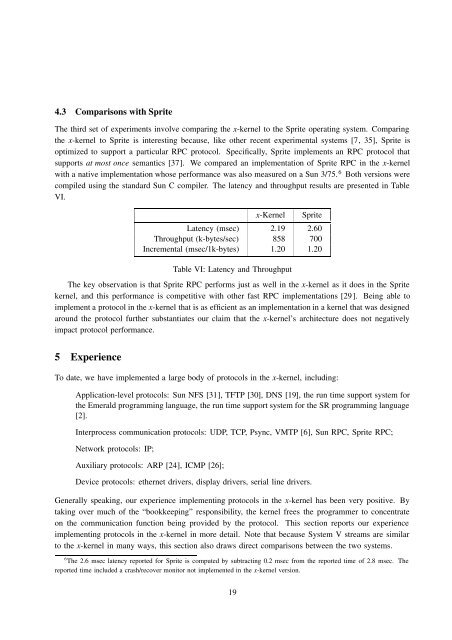The x-Kernel: An architecture for implementing network protocols - IDA
The x-Kernel: An architecture for implementing network protocols - IDA
The x-Kernel: An architecture for implementing network protocols - IDA
You also want an ePaper? Increase the reach of your titles
YUMPU automatically turns print PDFs into web optimized ePapers that Google loves.
4.3 Comparisons with Sprite<br />
<strong>The</strong> third set of experiments involve comparing the x-kernel to the Sprite operating system. Comparing<br />
the x-kernel to Sprite is interesting because, like other recent experimental systems [7, 35], Sprite is<br />
optimized to support a particular RPC protocol. Specifically, Sprite implements an RPC protocol that<br />
supports at most once semantics [37]. We compared an implementation of Sprite RPC in the x-kernel<br />
with a native implementation whose per<strong>for</strong>mance was also measured on a Sun 3/75. 6 Both versions were<br />
compiled using the standard Sun C compiler. <strong>The</strong> latency and throughput results are presented in Table<br />
VI.<br />
x-<strong>Kernel</strong> Sprite<br />
Latency (msec) 2.19 2.60<br />
Throughput (k-bytes/sec) 858 700<br />
Incremental (msec/1k-bytes) 1.20 1.20<br />
Table VI: Latency and Throughput<br />
<strong>The</strong> key observation is that Sprite RPC per<strong>for</strong>ms just as well in the x-kernel as it does in the Sprite<br />
kernel, and this per<strong>for</strong>mance is competitive with other fast RPC implementations [29]. Being able to<br />
implement a protocol in the x-kernel that is as efficient as an implementation in a kernel that was designed<br />
around the protocol further substantiates our claim that the x-kernel’s <strong>architecture</strong> does not negatively<br />
impact protocol per<strong>for</strong>mance.<br />
5 Experience<br />
To date, we have implemented a large body of <strong>protocols</strong> in the x-kernel, including:<br />
Application-level <strong>protocols</strong>: Sun NFS [31], TFTP [30], DNS [19], the run time support system <strong>for</strong><br />
the Emerald programming language, the run time support system <strong>for</strong> the SR programming language<br />
[2].<br />
Interprocess communication <strong>protocols</strong>: UDP, TCP, Psync, VMTP [6], Sun RPC, Sprite RPC;<br />
Network <strong>protocols</strong>: IP;<br />
Auxiliary <strong>protocols</strong>: ARP [24], ICMP [26];<br />
Device <strong>protocols</strong>: ethernet drivers, display drivers, serial line drivers.<br />
Generally speaking, our experience <strong>implementing</strong> <strong>protocols</strong> in the x-kernel has been very positive. By<br />
taking over much of the “bookkeeping” responsibility, the kernel frees the programmer to concentrate<br />
on the communication function being provided by the protocol. This section reports our experience<br />
<strong>implementing</strong> <strong>protocols</strong> in the x-kernel in more detail. Note that because System V streams are similar<br />
to the x-kernel in many ways, this section also draws direct comparisons between the two systems.<br />
6 <strong>The</strong> 2.6 msec latency reported <strong>for</strong> Sprite is computed by subtracting 0.2 msec from the reported time of 2.8 msec. <strong>The</strong><br />
reported time included a crash/recover monitor not implemented in the x-kernel version.<br />
19

















